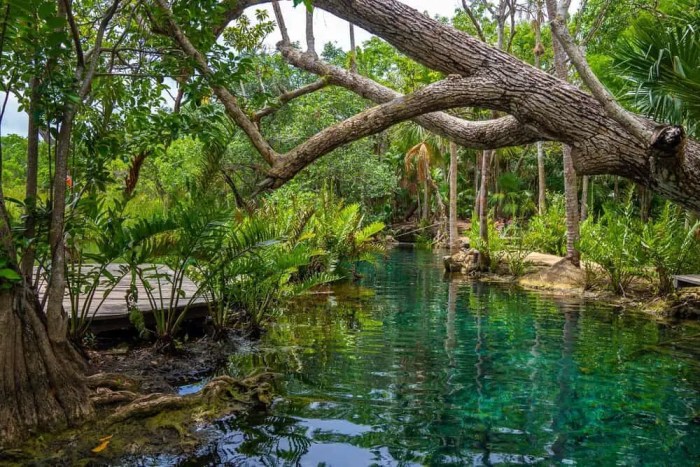As the world becomes increasingly aware of the environmental and social impacts of travel, sustainable travel destinations are emerging as a beacon of hope for a more responsible and regenerative approach to tourism. From reducing carbon footprints to preserving local cultures, sustainable travel destinations offer a unique blend of exploration, conservation, and community engagement.
In this comprehensive guide, we delve into the world of sustainable travel destinations, exploring their environmental, economic, and social impacts, and showcasing examples of destinations that are leading the way in sustainable tourism.
Overview of Sustainable Travel Destinations
Sustainable travel encompasses the practices of traveling in a way that minimizes negative impacts on the environment, supports local communities, and preserves cultural heritage while enhancing the overall travel experience.
Its significance lies in the preservation of natural resources, the protection of biodiversity, the reduction of carbon emissions, the promotion of cultural understanding, and the creation of local economic opportunities.
Sustainable Travel Practices and Their Benefits
- Using public transportation, walking, or cycling instead of driving to reduce carbon emissions and air pollution.
- Choosing accommodations that prioritize energy efficiency, water conservation, and waste reduction.
- Supporting local businesses, such as restaurants, shops, and tour operators, to strengthen the local economy.
li>Respecting local customs, traditions, and cultural heritage to preserve the destination’s authenticity.
Case Studies of Successful Sustainable Travel Destinations
Costa Rica: Known for its lush rainforests, abundant wildlife, and commitment to eco-tourism, Costa Rica has implemented sustainable practices throughout its tourism industry.
Bhutan: This Himalayan kingdom prioritizes Gross National Happiness over economic growth, promoting sustainable tourism that preserves its pristine environment and rich cultural traditions.
Environmental Impact of Sustainable Travel Destinations
Tourism has a significant environmental impact, contributing to greenhouse gas emissions, water pollution, and waste generation. Sustainable travel practices aim to minimize these impacts and preserve the natural and cultural heritage of destinations.
According to the World Tourism Organization (UNWTO), tourism accounts for approximately 8% of global greenhouse gas emissions. Air travel is a major contributor, with long-haul flights releasing large amounts of carbon dioxide. Other environmental impacts include water pollution from sewage and wastewater discharge, waste generation from packaging and food scraps, and damage to ecosystems from overtourism.
Mitigating Environmental Impacts
Sustainable travel practices can mitigate these environmental impacts by:
- Promoting alternative modes of transportation, such as walking, cycling, and public transport, to reduce carbon emissions.
- Encouraging the use of renewable energy sources in accommodation and attractions.
- Implementing water conservation measures, such as rainwater harvesting and low-flow fixtures.
- Protecting ecosystems by limiting access to sensitive areas and promoting responsible wildlife viewing.
li>Reducing waste generation through recycling, composting, and promoting reusable items.
Social Impact of Sustainable Travel Destinations

Sustainable tourism offers numerous social benefits for local communities. It promotes the preservation of cultural heritage, supports local businesses, and fosters cross-cultural understanding.
By embracing responsible practices, sustainable travel destinations can improve the health, education, and well-being of residents.
Economic Empowerment
Sustainable tourism creates economic opportunities for local communities, generating income and fostering entrepreneurship. This can lead to improved living standards, reduced poverty, and increased access to essential services.
When planning your next family vacation, consider sustainable travel destinations that prioritize environmental preservation while offering memorable experiences. From eco-friendly resorts to national parks, there are many best family vacation spots that align with sustainable practices. By choosing these destinations, you can minimize your environmental impact while creating lasting memories for your loved ones.
For example, in Costa Rica, ecotourism has created jobs and supported the development of local businesses, empowering communities to protect their natural resources while improving their economic well-being.
Cultural Preservation
Sustainable tourism encourages the preservation and celebration of local cultures. By respecting local customs and traditions, visitors can help protect cultural heritage and promote cross-cultural understanding.
In Bhutan, for instance, tourism is regulated to minimize its impact on the country’s unique culture and environment. This approach has allowed Bhutan to preserve its traditional way of life while benefiting from tourism revenue.
Health and Well-being
Sustainable tourism can improve the health and well-being of local communities by promoting access to healthcare, education, and clean water. Tourism revenue can be invested in infrastructure and services that benefit residents.
Sustainable travel destinations are becoming increasingly popular for families looking to minimize their environmental impact while creating lasting memories. These destinations offer a wide range of activities and attractions that are both educational and entertaining, making them ideal for best family vacation spots.
From exploring national parks and wildlife sanctuaries to visiting eco-friendly resorts and farms, there are countless ways to connect with nature and learn about sustainability while having fun.
In Kenya, tourism has funded the construction of schools and hospitals in rural areas, providing access to education and healthcare for local communities.
To make the most of your sustainable travel adventures, consider using a travel itinerary template. These tools can help you plan your trip efficiently, ensuring you maximize your time and experiences while minimizing your environmental impact. Whether you’re exploring eco-friendly destinations or seeking immersive cultural encounters, a well-crafted itinerary will guide you towards a sustainable and memorable journey.
Education and Awareness
Sustainable tourism raises awareness about environmental and social issues, fostering a sense of responsibility among visitors and locals alike. Educational programs and tours can inform visitors about the importance of protecting the environment and respecting local cultures.
In the Galapagos Islands, tourism has helped fund conservation efforts and educate visitors about the unique ecosystem, promoting responsible tourism practices.
Responsible Tourism
Responsible tourism is essential for maximizing the social benefits of sustainable travel destinations. Visitors should respect local customs, minimize their environmental impact, and support local businesses.
By adhering to these principles, tourists can help ensure that the benefits of tourism are shared equitably with local communities.
Examples of Sustainable Travel Destinations

Sustainable travel destinations prioritize environmental conservation, social responsibility, and economic sustainability. These destinations offer unique attractions and visitor experiences while minimizing their ecological impact and promoting the well-being of local communities.
Here are a few examples of sustainable travel destinations worldwide:
| Destination | Sustainable Practices | Unique Attractions | Visitor Experiences |
|---|---|---|---|
| Costa Rica | – Preserves over 25% of its land as national parks and protected areas. – Promotes ecotourism and sustainable agriculture. – Invests in renewable energy sources. |
– Rich biodiversity, including rainforests, cloud forests, and volcanoes. – Stunning beaches and coastline. – Adventure activities like zip-lining and white-water rafting. |
– Wildlife viewing in national parks. – Hiking and exploring diverse ecosystems. – Volunteering in conservation projects. |
| Bhutan | – Maintains a carbon-negative status. – Preserves its traditional culture and values. – Promotes sustainable agriculture and tourism. |
– Majestic Himalayan mountains and valleys. – Ancient Buddhist monasteries and temples. – Unique festivals and cultural events. |
– Trekking to remote villages and monasteries. – Experiencing traditional Bhutanese cuisine and customs. – Participating in spiritual and cultural festivals. |
| Iceland | – Utilizes geothermal and hydroelectric energy. – Preserves its pristine natural landscapes. – Promotes responsible tourism practices. |
– Northern Lights and midnight sun. – Glaciers, volcanoes, and waterfalls. – Wildlife viewing, including whales and puffins. |
– Hiking and exploring glaciers and volcanoes. – Whale watching and puffin spotting. – Visiting geothermal hot springs and swimming pools. |
| Slovenia | – Protects over 60% of its territory as protected areas. – Encourages sustainable tourism and transportation. – Supports local communities and cultural heritage. |
– Picturesque Alpine landscapes and forests. – Caves, lakes, and rivers. – Charming towns and historical sites. |
– Hiking and biking through pristine wilderness. – Visiting medieval castles and exploring caves. – Enjoying local cuisine and cultural events. |
Best Practices for Promoting Sustainable Travel
Sustainable travel practices aim to minimize the negative environmental and social impacts of tourism while preserving and enhancing the natural and cultural heritage of destinations. Promoting sustainable travel requires a collaborative effort involving various stakeholders, including tourism businesses, governments, and travelers themselves. Effective promotion strategies can raise awareness, educate tourists, and encourage responsible travel behavior.
Education and Awareness
Educating tourists about the importance of sustainable travel is crucial. This can be achieved through various channels, such as:
*
- Educational campaigns: Raising awareness about the environmental and social impacts of tourism and promoting sustainable practices.
- Online resources: Providing easily accessible information on sustainable travel destinations, best practices, and responsible travel tips.
- Collaboration with travel agents: Partnering with travel agents to incorporate sustainability information into travel itineraries and offer sustainable travel options.
Responsible Marketing, Sustainable travel destinations
Responsible marketing plays a significant role in promoting sustainable travel. Tourism businesses should adopt ethical and transparent marketing practices that:
*
- Avoid greenwashing: Accurately representing sustainability initiatives and avoiding misleading claims.
- Highlight local experiences: Promoting local businesses, cultural experiences, and community engagement to support local economies.
- Promote responsible travel practices: Educating tourists about minimizing their environmental and social impact through responsible behavior.
Tips for Travelers
Travelers can also contribute to sustainable tourism by adopting responsible practices:
*
- Choose sustainable destinations: Opting for destinations that prioritize environmental protection, social responsibility, and cultural preservation.
- Support local businesses: Patronizing locally owned businesses, using local transportation, and participating in community activities to support the local economy.
- Minimize environmental impact: Reducing waste, conserving energy, and respecting wildlife and natural habitats.
- Respect local cultures: Being mindful of local customs, traditions, and dress codes, and interacting with locals in a respectful and understanding manner.
Future of Sustainable Travel Destinations

The future of sustainable travel destinations is promising, with an increasing number of travelers seeking responsible and eco-friendly experiences. Sustainable tourism practices not only protect the environment and local communities but also contribute to economic growth.
Technology and innovation play a significant role in promoting sustainability in travel. Online platforms connect travelers with local businesses, reducing the carbon footprint associated with transportation. Digital tools provide information on sustainable practices, allowing travelers to make informed choices.
The future of sustainable travel destinations is characterized by:
– Increased adoption of renewable energy sources and energy-efficient practices
– Enhanced waste management systems and reduced plastic consumption
– Support for local businesses and community involvement
– Education and awareness campaigns to promote responsible travel practices
– Collaboration between stakeholders to ensure sustainable development
Sustainable travel destinations will continue to grow in popularity, as travelers become more conscious of the impact of their choices. The tourism industry will need to adapt to meet the evolving demands of travelers, embracing sustainable practices to ensure a thriving future for the sector.
Closing Summary

The future of sustainable travel destinations is bright, with technology and innovation playing a key role in driving sustainability efforts. As travelers become more aware of the importance of responsible tourism, sustainable travel destinations will continue to grow in popularity, creating a positive impact on local communities and the environment alike.
Query Resolution: Sustainable Travel Destinations
What is sustainable travel?
Sustainable travel is a form of tourism that seeks to minimize negative environmental and social impacts while maximizing positive economic, social, and environmental outcomes for local communities.
What are the benefits of sustainable travel?
Sustainable travel offers a range of benefits, including reducing carbon emissions, preserving biodiversity, protecting cultural heritage, creating jobs, and supporting local economies.
How can I travel more sustainably?
There are many ways to travel more sustainably, such as choosing low-carbon transportation options, staying in eco-friendly accommodations, supporting local businesses, and respecting local customs and traditions.